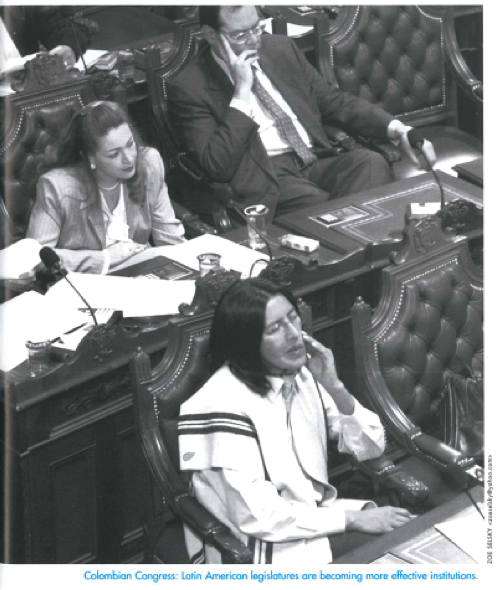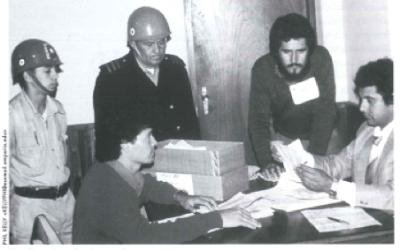Constitutional Reform

You say you’ll change the constitution,” Beatle John Lennon once wrote. Latin American countries have long been singing this same tune, often blaming their presidential constitutions for the cycles of political and economic turbulence of the past decades. Indeed, presidentialism has not been without fault in many historical incidents of democratic breakdown in the region.
The alternative to presidentialism most often proposed and discussed by practitioners and scholars is parliamentarism—a constitutional type found in stable postwar European democracies, such as the United Kingdom and Germany. But of late, one very intriguing “alternative to the alternative” tends to pop up, as Latin American countries consider constitutional reform à la française. Argentina, Venezuela, and Brazil, for example, have all considered the French model at some point during their democratizations.
Why such attraction to the French model? First, the constitution of the French Fifth Republic (1958) has been praised for helping France make a very successful regime transition in the early 1960s. Barely able to pick up the pieces after the turbulent Fourth Republic, still suffering the pain of de-colonization, France successfully rediscovered its democracy equilibrium under a semi-presidential constitution. Within a decade, French political parties, once unwilling to cooperate and form stable coalitions, began to coalesce into a workable system with coalitions that supported not only prime ministers, but also presidents. Given Latin America’s history of inchoate party systems and presidents without legislative support, the French about-face is fascinating. Can it be emulated? If the constitution played a role in this dramatic change, isn’t such a constitution worth a try in the Americas?
Second, semi-presidentialism appears to be a magnificent institutional compromise. Why make a drastic switch to parliamentarism? Latin Americans opting for semi-presidentialism would not have to give up the historically significant office of the president. They could, it is thought, get the best of both worlds: all the benefits of parliamentary government, without the radical change implied by parliamentarism. What a great solution!
Or is it? Looking a bit more closely at its actual structure, one quickly sees that semi-presidentialism is as awkward as it sounds. It is a constitutional type that curiously combines elements of both presidentialism and parliamentarism, and this combination produces conflicting logics. For example, the head of state in this type is usually a directly elected president with substantial constitutional powers. This head of state then shares executive power with a head of government, usually called a prime minister, who is responsible to the legislature.
Under certain party system conditions, a semi-presidential constitution combines the most problematic variety of presidential government (the divided government that Latin America knows well), with the most problematic variety of parliamentary government (the minority government that plagued much of the French Fourth Republic). This yields a nightmarish situation that I’ve termed divided minority government. In such a scenario, the president is divided from the legislature (as in the U.S. during Bill Clinton’s second term), with all the deadlock and conflict that this division implies. At the same time, the legislature is divided against itself (as in the last years of the Weimar Republic), and may be utterly unable to support any government for a sustained period of time. Adding insult to injury, the president in this variety of semi-presidentialism is usually also divided against his prime minister (as Jacques Chirac and Lionel Jospin were in France until recently). These multi-layered, mutually reinforcing political divisions are institutionally structured; they are a consistent consequence of the constitution and its interaction with a country’s political party dynamics.
So, what’s so attractive about that? Let’s continue to the logical conclusion. Divided minority government is particularly vulnerable to institutional conflict and, in the extreme, to democratic breakdown. The absence of any clear majority in the legislature can easily lead to an unstable scenario. On one hand, legislative coalitions constantly shift, and the government inevitably reshuffles. On the other hand, there is continuous presidential intervention and use of reserved powers. We witnessed this vicious circle in one of the newest semi-presidential countries: Russia. Under Boris Yeltsin, the greater the legislative immobilism, governmental instability, and cabinet reshuffling resulting from failed majorities in the Duma, the more institutional incentives Yeltsin had to dominate the political process and rule by decree.
The real problems with semi-presidentialism start here. A divided minority government can be a slippery slope to dictatorship: a president who relies extensively on decrees and ignores the democratically elected legislature moves the country into a state of hyper-presidentialism, narrowing the decision-making arena to a small number of hand-picked, non-party technocrats. This technocratization of cabinets hinders the democratic principles of inclusion and contestation; it divides the government even further from the legislature; and it cramps parliamentary responsibility. Sound familiar?
So how did France make it? France’s experience with semi-presidentialism may have been simply exceptional. France’s party system institutionalized relatively quickly within the first decade of the Fifth Republic, evidenced by a steady decline in electoral volatility. Moreover, the strongly majoritarian electoral system in place since 1958 began to encourage two, center-leaning majorities in France. The Fifth Republic’s first president, Charles de Gaulle, gradually became less averse to political parties, and even began to lean on them for support. Successive presidents of the Fifth Republic followed suit. These favorable conditions encouraged the coincidental presidential and legislative majorities that kept France out of divided minority government for almost the entire Fifth Republic—and made semi-presidentialism workable.
How likely is it that countries such as Argentina or Venezuela would have such favorable initial conditions for workable semi-presidentialism? The track record to date does not look good. Many Latin American democracies continue to have poorly institutionalized party systems, presidents who continue to present themselves as standing “above” political parties, and proportional representation electoral formula designed to allow for multiple parties in the legislature. Thus, countries switching to semi-presidentialism will most likely be born in divided minority government and have a difficult time emerging from it.
Yet, as John Carey argues in this same issue, perhaps the tide is slowly changing, as Latin American legislatures become more effective institutions. Should party systems in the region finally consolidate, and if governmental crises continue to be resolved through democratic institutions rather than outside of them, a window of opportunity may open up for constitutional reform. Only then might countries be advised to move gently away from presidentialism, de jure, thereby consolidating some of the (still too rare) de facto parliamentary-like behavior we seem to be witnessing in the region.
Perhaps constitutional change is necessary in Latin America. But the sequencing of other changes that could support constitutional reform, such as the institutionalization of political parties, the strengthening of legislatures, and the general attitude of political elites, should not be ignored. As even John Lennon cautioned, “You say you’ll change the constitution. Well, you know, we all want to change your head.”
Fall 2002
Cindy Skachis Assistant Professor of Government at Harvard University. She is currently working on a cross-regional study of the complexity of the constitutional performance.
Related Articles
HACIA Democracy Social Justice and Democracy in Latin America
As I walked around the Harvard campus on a characteristically cold slushy day in February 1996, I spotted several bright posters with slanted palm trees, inviting students interested in Latin…
Fitzgibbon Survey: Measuring Democracy
As election observers in Asunción, we spent our spare time debating about how we would construct a better government in Paraguay, if given the opportunity. As we rode from interview…
Democracy in Latin America
Democratic institutions are facing stress throughout Latin America and experiencing serious challenges in some countries. The public has had little confidence in political parties and…




